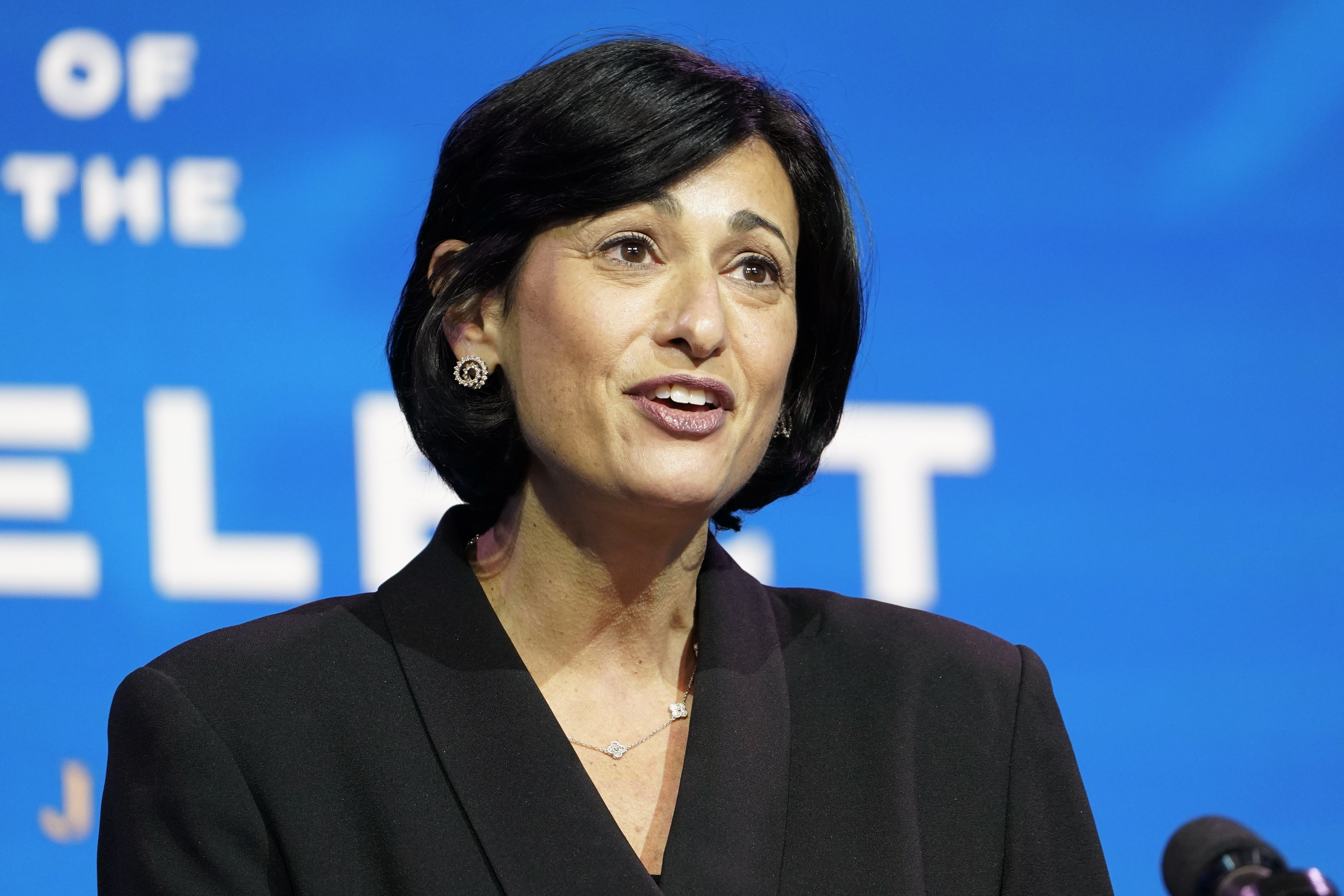There are fewer Massachusetts communities at the highest risk of coronavirus transmission this week than last week, state health data released Thursday shows.
The town-by-town coronavirus risk data -- which classifies communities' risk level on a scale from red, the highest, to grey -- puts 222 cities and towns in the red zone, from 229 last week. (See the full list of red zone communities below.)
The Department of Public Health also released its weekly vaccine dashboard Thursday, which showed that the number of doses shipped to the Bay State is down this week by 73%.
Get top local stories in Boston delivered to you every morning. Sign up for NBC Boston's News Headlines newsletter.
The data provides more insight on this winter's coronavirus surge in Massachusetts. But Gov. Charlie Baker said Thursday that progress is being made on that front, and saw fit to announce that some coronavirus restrictions will be eased starting next week. He also expanded the group now eligible to be vaccinated to everyone in Phase 1.
"Vaccines are reaching residents, positive case rates and hospitalizations have stabilized; those trends are moving in the right direction," Baker said. "As a result, we believe it's OK and it's time to start a gradual easing of some of the restrictions we put in place in the fall."
See Thursday's weekly vaccine report here and the town-by-town coronavirus data here.
Massachusetts COVID Hot Spots
The following 222 communities are in the highest risk level as of Thursday: Abington, Acushnet, Adams, Agawam, Amesbury, Andover, Ashburnham, Ashby, Ashland, Athol, Attleboro, Auburn, Avon, Ayer, Barnstable, Barre, Belchertown, Bellingham, Berkley, Berlin, Beverly, Billerica, Blackstone, Boston, Bourne, Boxborough, Boxford, Boylston, Braintree, Brewster, Bridgewater, Brimfield, Brockton, Brookfield, Burlington, Canton, Carver, Charlton, Chatham, Chelmsford, Chelsea, Chicopee, Clinton, Cohasset, Dalton, Danvers, Dartmouth, Dedham, Deerfield, Dennis, Dighton, Douglas, Dover, Dracut, Dudley, Duxbury, East Bridgewater, East Brookfield, East Longmeadow, Easton, Edgartown, Everett, Fairhaven, Fall River, Falmouth, Fitchburg, Foxborough, Framingham, Franklin, Freetown, Gardner, Georgetown, Gloucester, Grafton, Granby, Great Barrington, Groveland, Hadley, Halifax, Hamilton, Hampden, Hanover, Hanson, Harwich, Hatfield, Haverhill, Holbrook, Holden, Holliston, Holyoke, Hopedale, Hudson, Hull, Ipswich, Kingston, Lakeville, Lancaster, Lawrence, Lee, Leicester, Leominster, Littleton, Lowell, Ludlow, Lunenburg, Lynn, Lynnfield, Malden, Manchester, Mansfield, Marion, Marlborough, Marshfield, Mashpee, Mattapoisett, Maynard, Medford, Medway, Merrimac, Methuen, Middleborough, Middleton, Milford, Millbury, Millis, Monson, Nahant, Nantucket, New Bedford, Newbury, Norfolk, North Andover, North Attleborough, North Brookfield, North Reading, Norton, Norwell, Norwood, Oak Bluffs, Orange, Oxford, Palmer, Paxton, Peabody, Pembroke, Pepperell, Pittsfield, Plainville, Plymouth, Plympton, Quincy, Randolph, Raynham, Reading, Rehoboth, Revere, Rochester, Rockland, Rockport, Rowley, Rutland, Salem, Salisbury, Sandwich, Saugus, Scituate, Seekonk, Shirley, Shrewsbury, Somerset, Southampton, Southborough, Southbridge, Southwick, Spencer, Springfield, Sterling, Stoneham, Stoughton, Stow, Sturbridge, Sunderland, Sutton, Swampscott, Swansea, Taunton, Templeton, Tewksbury, Tisbury, Topsfield, Townsend, Tyngsborough, Upton, Uxbridge, Wakefield, Walpole, Waltham, Ware, Wareham, Warren, Webster, Wenham, West Boylston, West Bridgewater, West Brookfield, West Newbury, West Springfield, Westfield, Westford, Westminster, Westport, Westwood, Weymouth, Whitman, Wilbraham, Wilmington, Winchendon, Winthrop, Woburn, Worcester, Wrentham and Yarmouth.
That means 63% of all of Massachusetts' 351 communities are in the red zone; the report said the state as a whole is in it as well.
Of those communities, six are newly in red on the list this week: Ashby, Boxborough, Deerfield, Falmouth, Plympton and West Newbury.
And 13 communities dropped out of red: Cheshire, Easthampton, Hingham, Hopkinton, Longmeadow, Marblehead, Millville, Milton, Northborough, Orleans, Sherborn, Somerville and South Hadley.
To qualify for the red, high-risk category under the new metrics, communities with populations under 10,000 must have more than 25 cases. For mid-size communities of between 10,000 and 50,000 people, they must have an average of more than 10 cases per 100,000 people and a positive test rate of more than 5%. And for larger communities of greater than 50,000 people, they must have more than 10 cases per 100,000 people and a positive test rate of more than 4%.
Previously, the state used the number of cases detected on average each day over two weeks to determine if Massachusetts' communities are at high risk for coronavirus transmission. The new list factors in population size and positive test rate.
Read this week's full report here, with data on communities' percent positivity, county- and state-level data and more.
The Department of Public Health is no longer including a map of the community-level risk in the weekly report. An official told NBC10 Boston that the map is no longer seen as being as helpful as it once was, now that coronavirus cases are being reported in most communities.
Mass. Vaccine Data
This week's vaccine report from the Department of Public Health shows that 86,230 doses were given this week, for a total of 359,919 doses in all. The report no longer breaks down the data by first and second dose.
The two coronavirus vaccines approved so far in the country's fight against the pandemic, from Pfizer and Cambridge-based Moderna, both require that people receive two doses, which are recommended to be spaced out over three or four weeks.
The pace that vaccines are being administered dropped by 24% in the weeklong period covered by Thursday's report, Jan. 13-19, compared to the week before.
There was an even bigger drop in the number of vaccine doses coming to Massachusetts. That was down 73% week over week, with only 52,225 doses being shipped to the commonwealth.
Shipments have been consistently lower than hoped for -- "I would love us to have five times the number of doses but we don't," Baker said earlier Thursday -- but Thursday's report did note the arrival of 157,300 Moderna doses on Jan. 12 that wasn't included in the report last week.
President Joe Biden on Thursday outlined his plan to ramp up vaccinations across the U.S., vowing "help is on the way."
Vaccines are the key to getting society back to normal, since they have been found to offer the greatest protection from serious complications in people who are infected with the virus. The widespread distribution of the vaccines will trigger the final phase in Massachusetts' reopening plan, when restrictions will be lifted.
Vaccinations began in Massachusetts last month. See the Baker administration's plan for rolling out the vaccine here.
Changes to Massachusetts' Hot Spot Data
The weekly report has a history of somewhat abrupt changes.
When Massachusetts health officials first unveiled a digital coronavirus dashboard in early January, they stopped releasing town-by-town coronavirus metrics on a weekly basis, since they are included in the "city and town" tab of the interactive dashboard. It shows communities' positive test rate and overall testing rate, though not other metrics that were included in the old format.
"Data previously found in this report, including town-by-town cases and testing reporting, can now be found in the daily interactive dashboard," a note in that week's pared-down weekly report said. But a new version of the report was issued later that night brought back the data.
More major changes before that knocked the number of communities in the red zone from 121 to 16 as what was defined a high-risk community changed. Officials said the adjustment brought Massachusetts more in line with risk levels in other states.
However, the numbers grew again as the weeks passed, eventually rising to 190 communities in the red zone before the data switched to the interactive dashboard.
That week's report also dropped the map that displayed the town-by-town coronavirus data. It showed where in the state communities were at high, moderate or low risk of transmission, but officials said it was no longer very informative.
In the weeks before that, officials added information on COVID-19 clusters, both on where major clusters have been identified -- they're listed in the report with an asterisk -- and on trends among clusters.
The color-coded town-by-town data was introduced in August, and the Baker administration announced that the state would focus its strongest COVID-mitigation efforts on towns in the red category. Communities can only move to Step 2 of Phase 3 of Massachusetts' reopening plan, announced in late September, if they are not consistently in the red.
Before the introduction of that data, the standard for measuring hot spots had been the positive COVID test rate over the preceding 14 days. The Department of Public Health's weekly report still includes that information, along with other metrics like how many tests are being conducted locally and how many cases have been reported locally.
Some of Massachusetts' smaller towns had taken issue with having their risk assessed based on cases per capita alone. They said that, when a town only had a few thousand people, an outbreak in just one household could send it into red under the criteria at the time: 8 cases of COVID-19 per 100,000 residents.



